ISSN ONLINE(2319-8753)PRINT(2347-6710)
ISSN ONLINE(2319-8753)PRINT(2347-6710)
S M Sivagami1, N Murugan2, A Elango3, S Suresh Kumar4
|
| Related article at Pubmed, Scholar Google |
Visit for more related articles at International Journal of Innovative Research in Science, Engineering and Technology
Weld hardfacing is mainly employed for improving wear, corrosion and heat resistant properties under high pressure and high temperature condition. The service life of the hardfaced component is increased by achieving the desired surface hardness which is identification to get the abrasive wear resistance. The macrohardness is generally influenced by welding process parameters such as welding current, welding speed, powder feed rate, plasma gas flow rate and oscillation frequency. Therefore, it is essential to develop mathematical models for the selection of appropriate welding process parameters that can predict the desired weld macrohardness. This paper mainly focuses the development of mathematical models using five factor, five level factorial technique to predict macrohardness in hardfaced gate valve. Analysis of variance was used to check the adequacy of the developed models. Also the empirical models developed were checked by conducting confirmation experiments. The effects of welding process parameters on the macrohardness are presented as graphs.
Keywords |
| Plasma Transferred Arc Surfacing Process, Stellite 6, and Macrohardness |
INTRODUCTION |
| Weld hardfacing is a process of depositing a powder material on the surface of carbon and low alloy steel base metal in order to improve the wear resistance. Gate Valve used in Oil and Natural Gas Corporation (ONGC) Ltd. India, are subjected to heavy wear and tear, resulting in reduced service life requiring frequent replacement. The replacement could be either through the whole material removal or coating the existing with superior wear resistant material. Therefore an extension of service life through coatings by a process called hardfacing [1], has significant cost savings. The quality of hardfaced gate valve is mainly influenced by macrohardness which is the basic identification to find the abrasive wear resistance of hardfaced overlay. It mainly depends on the volume fraction of carbides present in hardfaced overlay [2]. An increase in the volume fraction of carbides leads to a corresponding increase in the macroscopic hardness and for the wear resistance of the cobalt based alloy [3]. The macrohardness of the hardfaced overlay can be achieved by controlling the important PTA process parameters. Therefore, the main objective of this paper is to develop mathematical models to study the main and interaction effects of PTA process parameters on macrohardness of hardfaced overlay. |
II. EXPERIMENTAL WORK |
| The low alloy steel gate valve (Fig. 1) of size 200 mm x 88 mm x 50 mm has 2 mm groove on either sides on which Stellite 6 is deposited by PTAW hardfacing process. The gate valve is preheated to 450°C for one hour in an electric furnace before hardfacing alloy in order to remove moisture, avoid cold crack, and entrapped hydrogen as well as to minimize the residual stress induced [4]. The available area for depositing Stellite 6 on the rectangular side is 110 mm x 70 mm and annular area having inner and outer radius of 21 mm and 35 mm respectively on the hole side. Initially, the first linear bead was deposited for 110 mm length. At the end of first bead, second bead was deposited with 20 % overlap. Similar procedure was followed for depositing the remaining two weave beads with same overlap. After completing all four weave bead depositions on one side, a similar procedure was repeated for the other side also immediately. Fig. 2 shows a typical hardfaced gate valve having four linear overlay beads only. After all linear bead hardfacing, the gate valve was kept in an electric furnace at 450ºC for an hour before depositing Stellite 6 on the annular area in the hole side. After soaking for an hour, the gate valve was taken from the electric furnace and was hardfaced with Stellite 6 material to a width of 14 mm in the annular section with 10º overlap. Similar procedure was repeated for other side. After linear and circular weave bead hardfacing of gate valve, it was kept in an electric furnace to post heat at 630°C for two hours in order to prevent crack formation and to minimize residual stresses and distortion. Table 1 shows the levels of PTA process parameters used for depositing circular bead hardfacing. |
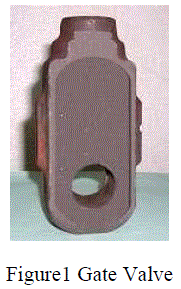 |
| After hardfacing the gate valve, the specimens of 10 mm thick were obtained by sectioned transversely using a wire cut Electric Discharge Machine (EDM) to examine circular overlay macrohardness. The samples were ground to a thickness equivalent to about 10 to 20% of the height of the reinforcement of hardfaced metal from the top surface to provide a sufficient flat area for macrohardness measurement. The Rockwell hardness testing machine was used to |
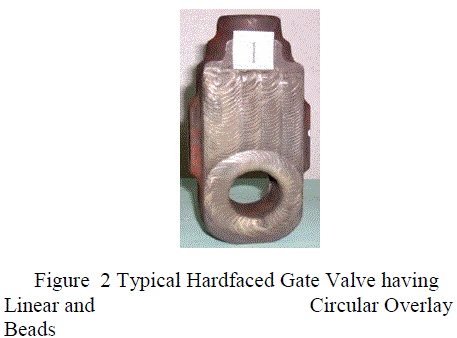 |
| take macrohardness at five different points on the top surface of specimen with a load of 150 kg and a loading time of 5 seconds and averaged these values. The estimated average macrohardness values of all the specimens are presented in Table 2. |
III. DEVELOPMENT OF MATHEMATICAL MODELS |
| The regression equation in coded form to predict the macrohardness of the weld metal is given in equation (1). |
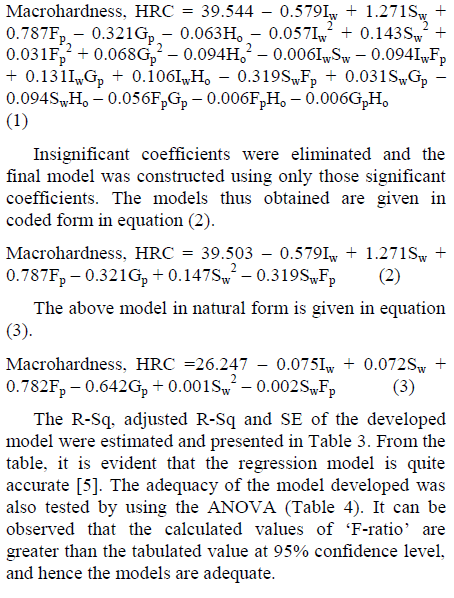 |
| The validity of the model is further tested by drawing scatter diagram as shown in Figure 3. The observed values and predicted values of the model are scattered close to 45° line, indicating an almost perfect fit of the developed empirical models. |
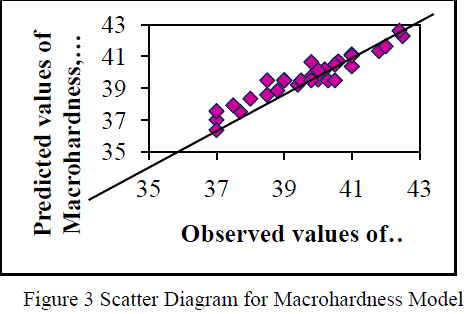 |
| Experiments were conducted to verify the developed regression equations. Two conformity trial runs were made using different values of the process parameters other than those used in the design matrix. Experimental values of macrohardness were compared with the predicted values of the macrohardness from the model represented in Table 5, and it is observed that the error in the predicted model is ± 1% at 95% confidence level |
IV. RESULTS AND DISCUSSION |
| A. Effects of PTA Process Parameters on Macrohardness of Circular Hardfaced Overlay Figure 4 shows the direct effects of PTA process parameters on macrohardness of the hardfaced overlay. It is evident from figure that macrohardness decreases with increase in welding |
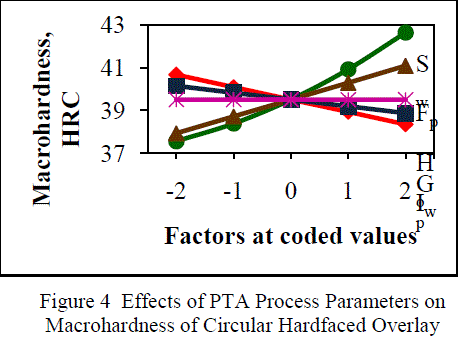 |
| current and plasma gas flow rate. This is due to increase in heat input with increase in welding current and plasma gas flow rate resulting in higher dilution. Macrohardness increases with increase in welding speed and powder feed rate which may be attributed to the reduction in heat input causing lesser dilution. Macrohardness is not significantly affected by oscillation frequency. |
V. CONCLUSION |
| The experiments were conducted to develop the mathematical models to study the effects of the process parameters on macrohardness for stellite-6 hardfaced gate valve. The following conclusions derived from the above investigation are: |
| The welding speed and powder feed rate had positive effect on the macrohardness of the hardfaced overlay. |
| The welding current and plasma gas flow rate had negative effect on the macrohardness of the hardfaced overlay. |
| The oscillation frequency appears to have no insignificant influence on the macrohardness of the hardfaced overlay. |
ACKNOWLEDGEMENT |
| The authors wish to thank Bharat Heavy Electricals Limited, Tiruchirapalli, India for providing the gate valves and facilities for conducting the experiments. They also wish to thank the management of Coimbatore Institute of Technology, Coimbatore for providing all the necessary facilities to carry out this work. |
References |
|